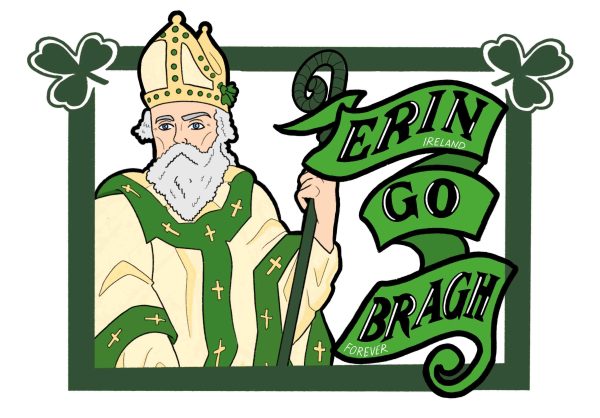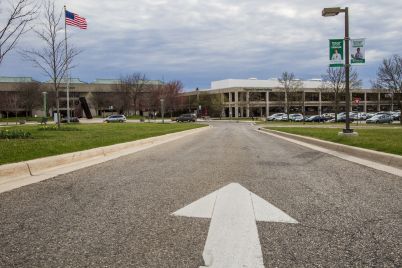
Saint Patrick, Apostle of Ireland and national motto “Ireland Forever.”
Charlie Todd
Contributor
Ireland is a country that prides itself in its ancient Gaelic culture, and when visiting the shamrock shores it is easy to see why.
The mighty waves of the Irish Sea crash into rock faces millions of years old, steeped in myth, history and religious significance. Dublin is a bustling metropolis with its prideful history seen in the preserved bullet holes in the General Post Office from the 1916 Easter Uprising.
The countryside is awash with fairy glens, ogham rocks and willow wisps.
When in Ireland, visitors are sent to a place where the real and the wondrous lose their boundaries and create a landscape of enriching fantasy.
It is no wonder that the ancient Celts felt so connected to their land.
They named their island Éire after the goddess of bounty and abundance, Ériu, making newcomers call it Éireland, or Ireland.
The Gaelic people were an ancient, diverse group of tribes and cultures stemming from the Iron Age (12,000 BCE). Gales had their own distinctive art, language and skilled craftsmen, all structured around chieftains and head Druids.
Their culture was one of the most significant in shaping the future of the British Isles, with their history and artifacts preserved at the National Museum of Ireland in Dublin.
Yet, there is a reason the Gaelic people are spoken about in past tense.
Over the centuries that Christianity spread across Europe, the Gaels were some of the last to be contacted by Roman Catholicism.
The National Museum in Dublin explains that in the fifth century CE a young Welshman was abducted from his coastal home by Gaelic pirates and brought to County Down on the east coast of Northern Ireland.
The boy was kept as a slave to shepherds for much of his young life, the work giving him time to connect with his faith and talk with his Christian God.
One day, the boy heard a celestial voice tell him to escape back to the port where a boat would be waiting to take him back to his homeland. Upon returning to Wales, that boy devoted his life to God and grew into a priest called Patrick.
As an adult, Patrick (not known by his given Welsh name, Maewyn Succat) returned to Ireland as a Catholic priest to proselytize and convert the druidic Celts to Catholicism.
According to Patrick, he single handedly converted thousands of “heathens” to know God. Today, the Catholic church honors him as the patron saint of Ireland, even though he wasn’t Irish.
A modern euphemism for St. Patrick’s work claims the man drove “the snakes” out of Ireland. In fact, he drove no one out of Ireland but pushed a new age religion on the Gaelic people so hard that their traditions and oral histories were mostly erased by Catholic and Roman invaders.
One Catholic myth about the creation of Ireland was preserved by the O’Doherty Heritage group (composed of the heads of multiple ancestral families of Ireland) states that a man was bit by a poisonous snake while in the desert with Moses, a prophet from “The Bible.”
When Moses used his staff to heal the wound, it turned green and that man went on to settle his people on the Emerald Isle where, to his joy, snakes are not indigenous.
Arguably, the church needs to get its legends in order.
According to many Catholic historians, when Patrick returned to his homeland, the Catholic Church charged him with multiple crimes mainly that of financial impropriety.
They heard from other priests in the area that Patrick had accepted bribes, charged fees for baptisms and kept expensive gifts from leaders.
The Church didn’t even believe that he was taken as a slave in boyhood, and if he had, he had returned only for vengeance against the people of his captors. Although known as a saint today, he was excommunicated and forced back to Ireland.
Thanks to the preservation of the Royal Irish Academy, we can see in Patrick’s later memoir, originally published in Latin as “Confessio”, Patrick wrote, “never before did [the Irish] know of God except to serve idols and unclean things.”
Today, modern pagans refuse to celebrate St. Patrick’s Day due to the saint’s work to erase their ancient culture.
It is common for pagans to wear snake pendants on March 17 out of protest and to signify that the “snakes” of Ireland are still alive.
In a 2023 religious census, there are approximately 100,000 pagans in the United Kingdom today—a far cry from the ancient ancestral orders of pagans the region boasted before Christianity.
In fact, in the 2020 World Druidry Survey, 75% of modern druids keep their religious practices private out of fear of discrimination from the larger JudeoChristian culture prominent in the UK today.
Today, Ireland is divided into the Republic of Ireland and Northern Ireland. The border between them is fraught with religious strife to which Ireland has been historically prone, with Belfast and Dublin being religiously opposed between the Protestant north and the Catholic south.
While Ireland continues to be a nation divided on religious beliefs, one thing has been clear throughout time: there were pagans before St. Patrick and there will be pagans long after him.


